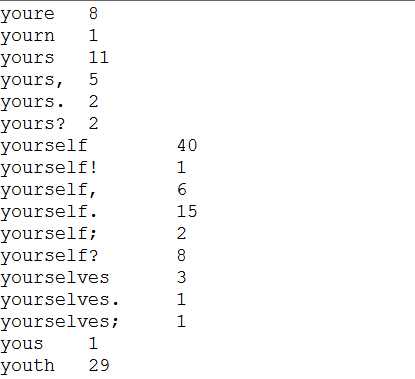标签:
尽管Hadoop框架是用java写的,但是Hadoop程序不限于java,可以用python、C++、ruby等。本例子中直接用python写一个MapReduce实例,而不是用Jython把python代码转化成jar文件。
例子的目的是统计输入文件的单词的词频。
1. Python MapReduce 代码
使用python写MapReduce的“诀窍”是利用Hadoop流的API,通过STDIN(标准输入)、STDOUT(标准输出)在Map函数和Reduce函数之间传递数据。
我们唯一需要做的是利用Python的sys.stdin读取输入数据,并把我们的输出传送给sys.stdout。Hadoop流将会帮助我们处理别的任何事情。
1.1 Map阶段:mapper.py
在这里,我们假设把文件保存到hadoop-0.20.2/test/code/mapper.py
#!/usr/bin/env python import sys for line in sys.stdin: line = line.strip() words = line.split() for word in words: print "%s\t%s" % (word, 1)
文件从STDIN读取文件。把单词切开,并把单词和词频输出STDOUT。Map脚本不会计算单词的总数,而是输出<word> 1。在我们的例子中,我们让随后的Reduce阶段做统计工作。
为了是脚本可执行,增加mapper.py的可执行权限
chmod +x hadoop-0.20.2/test/code/mapper.py
1.2 Reduce阶段:reducer.py
在这里,我们假设把文件保存到hadoop-0.20.2/test/code/reducer.py
#!/usr/bin/env python from operator import itemgetter import sys current_word = None current_count = 0 word = None for line in sys.stdin: line = line.strip() word, count = line.split(‘\t‘, 1) try: count = int(count) except ValueError: #count如果不是数字的话,直接忽略掉 continue if current_word == word: current_count += count else: if current_word: print "%s\t%s" % (current_word, current_count) current_count = count current_word = word if word == current_word: #不要忘记最后的输出 print "%s\t%s" % (current_word, current_count)
文件会读取mapper.py 的结果作为reducer.py 的输入,并统计每个单词出现的总的次数,把最终的结果输出到STDOUT。
为了是脚本可执行,增加reducer.py的可执行权限
chmod +x hadoop-0.20.2/test/code/reducer.py
细节:split(chara, m),第二个参数的作用,下面的例子很给力
str = ‘server=mpilgrim&ip=10.10.10.10&port=8080‘ print str.split(‘=‘, 1)[0] #1表示=只截一次 print str.split(‘=‘, 1)[1] print str.split(‘=‘)[0] print str.split(‘=‘)[1]
输出
|
1
2
3
4
|
servermpilgrim&ip=10.10.10.10&port=8080servermpilgrim&ip |
1.3 测试代码(cat data | map | sort | reduce)
这里建议大家在提交给MapReduce job之前在本地测试mapper.py 和reducer.py脚本。否则jobs可能会成功执行,但是结果并非自己想要的。
功能性测试mapper.py 和 reducer.py
|
1
2
3
4
5
6
7
8
9
10
11
12
13
14
|
[rte@hadoop-0.20.2]$cd
test/code[rte@code]$echo "foo
foo quux labs foo bar quux" |
./mapper.pyfoo 1foo 1quux 1labs 1foo 1bar 1quux 1[rte@code]$echo "foo
foo quux labs foo bar quux" |
./mapper.py
| sort -k1,1 |
./reducer.pybar 1foo 3labs 1quux 2 |
细节:sort -k1,1 参数何意?
-k, -key=POS1[,POS2] 键以pos1开始,以pos2结束
有时候经常使用sort来排序,需要预处理把需要排序的field语言在最前面。实际上这是
完全没有必要的,利用-k参数就足够了。
比如sort all
|
1
2
3
4
5
|
1 42 33 24 15 0 |
如果sort -k 2的话,那么执行结果就是
|
1
2
3
4
5
|
5 04 13 22 31 4 |
2. 在Hadoop上运行python代码
2.1 数据准备
我把上面三个文件放到hadoop-0.20.2/test/datas/目录下
2.2 运行
把本地的数据文件拷贝到分布式文件系统HDFS中。
bin/hadoop dfs -copyFromLocal /test/datas hdfs_in
查看
bin/hadoop dfs -ls
结果
|
1
|
drwxr-xr-x - rte
supergroup 0 2014-07-05 15:40 /user/rte/hdfs_in |
查看具体的文件
bin/hadoop dfs -ls /user/rte/hdfs_in
执行MapReduce job
bin/hadoop jar contrib/streaming/hadoop-*streaming*.jar -file test/code/mapper.py -mapper test/code/mapper.py -file test/code/reducer.py -reducer test/code/reducer.py -input /user/rte/hdfs_in/* -output /user/rte/hdfs_out
实例输出

查看输出结果是否在目标目录/user/rte/hdfs_out
bin/hadoop dfs -ls /user/rte/hdfs_out
输出
|
1
2
3
|
Found 2 itemsdrwxr-xr-x
- rte supergroup 0 2014-07-05 20:51 /user/rte/hdfs_out2/_logs-rw-r--r-- 2 rte
supergroup 880829 2014-07-05 20:51 /user/rte/hdfs_out2/part-00000 |
查看结果
bin/hadoop dfs -cat /user/rte/hdfs_out2/part-00000
输出

以上已经达成目的了,但是可以利用python迭代器和生成器优化
3. 利用python的迭代器和生成器优化Mapper 和 Reducer代码
3.1 python中的迭代器和生成器
3.2 优化Mapper 和 Reducer代码
mapper.py
#!/usr/bin/env python import sys def read_input(file): for line in file: yield line.split() def main(separator=‘\t‘): data = read_input(sys.stdin) for words in data: for word in words: print "%s%s%d" % (word, separator, 1) if __name__ == "__main__": main()
reducer.py
#!/usr/bin/env python from operator import itemgetter from itertools import groupby import sys def read_mapper_output(file, separator = ‘\t‘): for line in file: yield line.rstrip().split(separator, 1) def main(separator = ‘\t‘): data = read_mapper_output(sys.stdin, separator = separator) for current_word, group in groupby(data, itemgetter(0)): try: total_count = sum(int(count) for current_word, count in group) print "%s%s%d" % (current_word, separator, total_count) except valueError: pass if __name__ == "__main__": main()
细节:groupby
from itertools import groupby from operator import itemgetter things = [(‘2009-09-02‘, 11), (‘2009-09-02‘, 3), (‘2009-09-03‘, 10), (‘2009-09-03‘, 4), (‘2009-09-03‘, 22), (‘2009-09-06‘, 33)] sss = groupby(things, itemgetter(0)) for key, items in sss: print key for subitem in items: print subitem print ‘-‘ * 20
结果
|
1
2
3
4
5
6
7
8
9
10
11
12
13
|
>>>2009-09-02(‘2009-09-02‘, 11)(‘2009-09-02‘, 3)--------------------2009-09-03(‘2009-09-03‘, 10)(‘2009-09-03‘, 4)(‘2009-09-03‘, 22)--------------------2009-09-06(‘2009-09-06‘, 33)-------------------- |
注
4. 参考
Writing an Hadoop MapReduce Program in Python
版权声明:本文为博主原创文章,未经博主允许不得转载。
标签:
原文地址:http://blog.csdn.net/xum2008/article/details/47303729